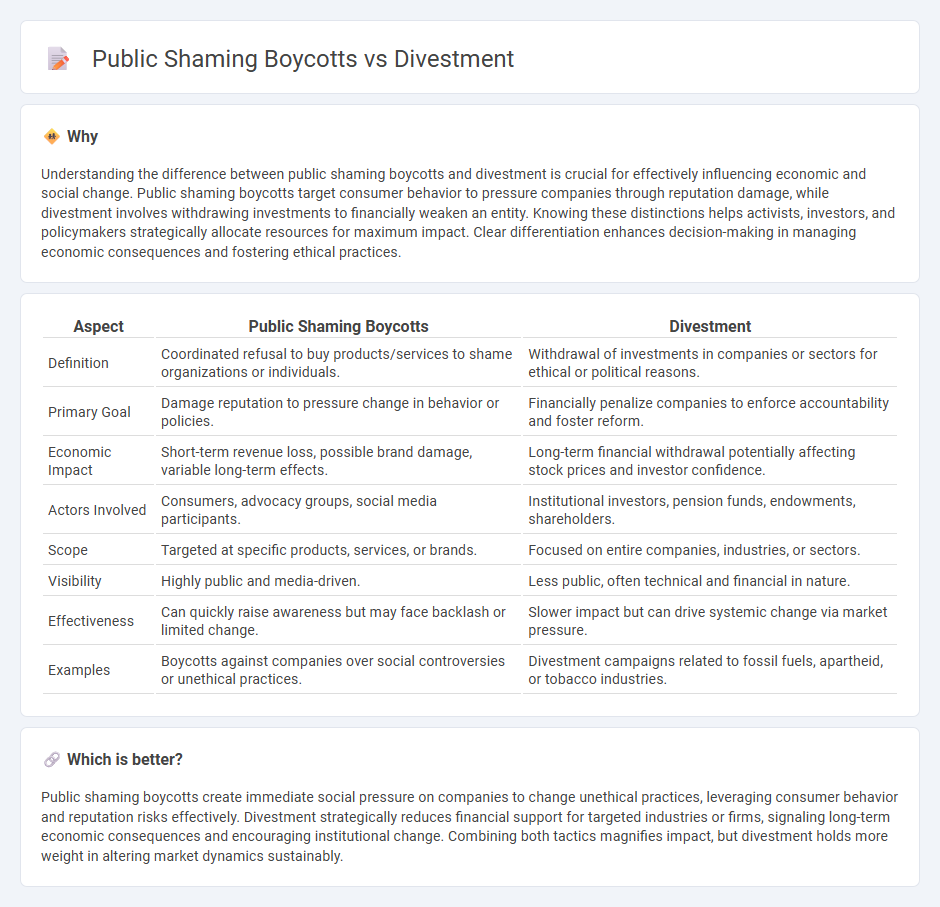
Public shaming boycotts leverage social pressure to influence corporations by targeting consumer behavior, aiming for immediate economic impact through reduced sales. Divestment involves withdrawing investments from companies to create long-term financial consequences and signal ethical concerns to shareholders and markets. Explore the differences in strategies and effects to understand their roles in economic activism.
Why it is important
Understanding the difference between public shaming boycotts and divestment is crucial for effectively influencing economic and social change. Public shaming boycotts target consumer behavior to pressure companies through reputation damage, while divestment involves withdrawing investments to financially weaken an entity. Knowing these distinctions helps activists, investors, and policymakers strategically allocate resources for maximum impact. Clear differentiation enhances decision-making in managing economic consequences and fostering ethical practices.
Comparison Table
| Aspect | Public Shaming Boycotts | Divestment |
|---|---|---|
| Definition | Coordinated refusal to buy products/services to shame organizations or individuals. | Withdrawal of investments in companies or sectors for ethical or political reasons. |
| Primary Goal | Damage reputation to pressure change in behavior or policies. | Financially penalize companies to enforce accountability and foster reform. |
| Economic Impact | Short-term revenue loss, possible brand damage, variable long-term effects. | Long-term financial withdrawal potentially affecting stock prices and investor confidence. |
| Actors Involved | Consumers, advocacy groups, social media participants. | Institutional investors, pension funds, endowments, shareholders. |
| Scope | Targeted at specific products, services, or brands. | Focused on entire companies, industries, or sectors. |
| Visibility | Highly public and media-driven. | Less public, often technical and financial in nature. |
| Effectiveness | Can quickly raise awareness but may face backlash or limited change. | Slower impact but can drive systemic change via market pressure. |
| Examples | Boycotts against companies over social controversies or unethical practices. | Divestment campaigns related to fossil fuels, apartheid, or tobacco industries. |
Which is better?
Public shaming boycotts create immediate social pressure on companies to change unethical practices, leveraging consumer behavior and reputation risks effectively. Divestment strategically reduces financial support for targeted industries or firms, signaling long-term economic consequences and encouraging institutional change. Combining both tactics magnifies impact, but divestment holds more weight in altering market dynamics sustainably.
Connection
Public shaming, boycotts, and divestment are interconnected strategies used to influence corporate behavior and economic policies by targeting a company's social and financial reputation. These tactics amplify consumer and investor pressure, leading to diminished sales, reduced stock value, and increased operational risks, which incentivize companies to adopt ethical practices or policy changes. By leveraging public opinion and capital flows, these methods effectively compel businesses and governments to align with social, environmental, or governance standards.
Key Terms
Capital reallocation
Divestment campaigns strategically redirect capital away from companies or sectors deemed unethical, aiming to weaken their financial influence through shareholder withdrawal and market pressure. Public shaming boycotts, while impactful in damaging brand reputation and consumer trust, primarily focus on demand reduction rather than directly reallocating investment capital. Explore how targeted divestment can reshape market dynamics and drive sustainable capital flows beyond simple consumer actions.
Social pressure
Divestment campaigns leverage financial pressure by urging institutions and investors to withdraw funds from companies with unethical practices, signaling a loss of legitimacy and harming economic interests. Public shaming boycotts apply direct social pressure by mobilizing consumer outrage via social media and public demonstrations to damage brand reputation swiftly. Explore how these strategies impact corporate behavior and drive social change.
Consumer activism
Consumer activism employs divestment by urging investors to withdraw assets from companies that engage in unethical practices, directly impacting their financial stability and reputation. Public shaming boycotts rely on coordinated consumer efforts to tarnish brand image and decrease sales, creating immediate social and economic pressure. Explore these strategies further to understand how consumer activism drives corporate accountability.
Source and External Links
The Institute for Sustainable Finance - Primer - Divestment - Divestment refers to the act of selling securities or assets in a portfolio, often for ethical reasons to promote social change, such as divesting from tobacco or environmentally harmful industries.
Divestment - Overview, Reasons, Challenges - Divestment is the sale of an existing business or asset that no longer meets performance expectations or strategic goals, commonly done to improve financial health or focus on core operations.
divestment | Wex | US Law | LII / Legal Information Institute - Divestment legally involves selling off subsidiaries, investments, or assets for financial, ethical, or political purposes, requiring removal of the asset from a company's financial records.
 dowidth.com
dowidth.com